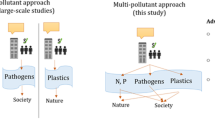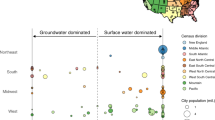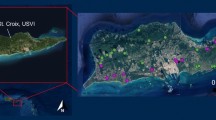Abstract
Background
The fire at the Intercontinental Terminals Company (ITC, Deer Park, La Porte, TX, USA) from March 17 to 20, 2019 resulted in substantial releases of chemical contaminants to the environment, including the surface waters of the Houston Ship Channel.
Objective
To characterize spatial and temporal trends, as well as potential human health risks, from these releases.
Methods
Out of 433 substances with available data, seven were selected for analysis: benzene, toluene, ethylbenzene, xylenes, oil and grease, suspended solids, and total petroleum hydrocarbons. Spatial and temporal concentration trends were characterized, and hazard quotients and cancer risks were calculated to estimate the potential for human health impacts from these contaminants.
Results
Temporal analysis showed presence of these chemical contaminants in water immediately after the event; their concentrations dissipated substantially within 4 weeks. The spatial distribution of contaminants indicated the highest concentrations in the waterways within about 1 km of the ITC. The greatest potential human health risks stemmed from presence of benzene.
Significance
A short-term but substantial spike in the concentrations of a number of hazardous contaminants occurred near the incident, with concentrations returning to apparent baseline levels within 1 month likely due to a combination of volatization, dilution and degradation.
This is a preview of subscription content, access via your institution
Access options
Subscribe to this journal
Receive 6 print issues and online access
$259.00 per year
only $43.17 per issue
Buy this article
- Purchase on Springer Link
- Instant access to full article PDF
Prices may be subject to local taxes which are calculated during checkout







Similar content being viewed by others
References
Wood MH, Fabbri L. Challenges and opportunities for assessing global progress in reducing chemical accident risks. Prog Disaster Sci. 2019;4:100044.
Tinney VA, Anenberg SC, Kaszniak M, Robinson B. Eighteen years of recommendations to prevent industrial chemical incidents: results and lessons learned of the US Chemical Safety Board. Public Health. 2016;139:183–8.
Miller A, Birnbaum L. Preparing for disasters. Science. 2015;348:766–7.
Kamath T, Strauss D. FINAL REPORT: ITC Deer Park fire was accidental, caused by failure in manifold of tank. Click2Houston. 2019. https://www.click2houston.com/news/local/2019/12/06/final-report-itc-deer-park-fire-was-accidental-caused-by-failure-in-tank/ Accessed 9 Nov 2020.
Treviso P. The ITC fire created 20 million gallons of waste. Getting rid of it is no easy task. Houston Chronicle. 2019. https://www.houstonchronicle.com/news/houston-texas/houston/article/It-took-days-to-put-out-the-ITC-tank-fire-that-14109491.php Accessed 9 Nov 2020.
ABC13-Houston. ITC Deer Park facility fire cause determined. 2019. https://abc13.com/itc-deer-park-fire-plant/5737588/ Accessed 9 Nov 2020.
An Han H, Han I, McCurdy S, Whitworth K, Delclos G, Rammah A, et al. The Intercontinental Terminals chemical fire study: a rapid response to an industrial disaster to address resident concerns in Deer Park, Texas. Int J Environ Res public health. 2020;17:986.
Aly NA, Luo YS, Liu Y, Casillas G, McDonald TJ, Kaihatu JM, et al. Temporal and spatial analysis of per and polyfluoroalkyl substances in surface waters of Houston ship channel following a large-scale industrial fire incident. Environ Pollut. 2020;265:115009.
TCEQ. ITC Response: Story Map. 2019. https://www.tceq.texas.gov/response/itc-response-story-map. Accessed 9 Nov 2020.
KHOU. Timeline: ITC chemical tank fire in Deer Park. 2019. https://www.khou.com/article/news/timeline-itc-chemical-tank-fire-in-deerpark/285-960722df-3907-49c4-91ef-25dc5250dfe1 Accessed 9 Nov 2020.
Shapiro A. Eparm data fetcher. https://gist.github.com/shapiromatron/e46748a618f81b4319b83ccd789e92db. Accessed 9 Nov 2020.
U.S. EPA. ITC Fire Response. 2019. https://epa.maps.arcgis.com/apps/Cascade/index.html?appid=f5eca85b79484cd69ea3a68cec886797. Accessed 9 Nov 2020.
Williams P, Benton L, Warmerdam J, Sheehans P. Comparative risk analysis of six volatile organic compounds in California drinking water. Environ Sci Technol. 2002;36:4721–8.
Adeniji AO, Okoh OO, Okoh AI. Petroleum Hydrocarbon Fingerprints of Water and Sediment Samples of Buffalo River Estuary in the Eastern Cape Province, South Africa. J Anal Methods Chem. 2017;2017:2629365.
Wegener SFaM. Spatial models and GIS: New and potential models. USA and Canada: Taylor & Francis; 2000.
U.S. EPA 2019. National Primary Drinking Water Regulations. https://www.epa.gov/ground-water-and-drinking-water/national-primary-drinkingwater-regulations. Accessed 9-Nov-2020.
U.S. EPA 2019. National Recommended Water Quality Criteria--Human Health Criteria Table. https://www.epa.gov/wqc/national-recommended-waterquality-criteria-human-health-criteria-table. Accessed 9 Nov 2020.
U.S. EPA. 2018 Edition of the Drinking Water Standards and Health Advisories. Washington, D.C.: U.S. Environmental Protection Agency; 2018.
Masekameni MD, Moolla R, Gulumian M, Brouwer D. Risk assessment of benzene, toluene, ethyl benzene, and xylene concentrations from the combustion of coal in a controlled laboratory environment. Int J Environ Res Public Health. 2019;16:95. https://doi.org/10.3390/ijerph16010095.
Loomis D, Guyton KZ, Grosse Y, El Ghissassi F, Bouvard V, Benbrahim-Tallaa L, et al. Carcinogenicity of benzene. Lancet Oncol. 2017;18:1574–5. https://doi.org/10.1016/S1470-2045(17)30832-X.
U.S. EPA. 2003. Benzene. https://cfpub.epa.gov/ncea/iris2/chemicalLanding.cfm?substance_nmbr=276. Accessed 9 Nov 2020.
DSHS. ADV-55 Fish and Shellfish Consumption Advisory for Galveston Bay Estuary. In: Department of State Health Services, (ed). Austin, TX: Texas Department of State Health Services; 2015.
TCEQ 2018. Chapter 307 - Texas Surface Water Quality Standards Rule Project No. 2016-002-307-OW https://www.tceq.texas.gov/assets/public/waterquality/standards/tswqs2018/2018swqs_allsections_nopreamble.pdf. Accessed 9 Nov 2020.
Rama F, Ramos DT, Muller JB, Corseuil HX, Miotlinski K. Flow field dynamics and high ethanol content in gasohol blends enhance BTEX migration and biodegradation in groundwater. J Contam Hydrol. 2019;222:17–30.
Essaid HI, Cozzarelli IM, Eganhouse RP, Herkelrath WN, Bekins BA, Delin GN. Inverse modeling of BTEX dissolution and biodegradation at the Bemidji, MN crude-oil spill site. J Contam Hydrol. 2003;67:269–99.
Abdunaser K. Spatio-temporal analysis of oil lake and oil-polluted surfaces from remote sensing data in one of the Libyan oil fields. Sci Rep. 2020;10:20174.
Turner RE, Rabalais NN, Overton EB, Meyer BM, McClenachan G, Swenson EM, et al. Oiling of the continental shelf and coastal marshes over eight years after the 2010 Deepwater Horizon oil spill. Environ Pollut. 2019;252:1367–76.
Wade TL, Sericano JL, Sweet ST, Knap AH, Guinasso NL Jr. Spatial and temporal distribution of water column total polycyclic aromatic hydrocarbons (PAH) and total petroleum hydrocarbons (TPH) from the Deepwater Horizon (Macondo) incident. Mar Pollut Bull. 2016;103:286–93.
Qu J, Meng X, Ye X, You H. Characteristic variation and original analysis of emergent water source pollution accidents in China between 1985 and 2013. Environ Sci Pollut Res Int. 2016;23:19675–85.
Oliver AA, Reuter JE, Heyvaert AC, Dahlgren RA. Water quality response to the Angora fire, Lake Tahoe, California. Biogeochemistry. 2012;111:361–76.
Smith HG, Sheridan GJ, Lane PN, Nyman P, Haydon S. Wildfire effects on water quality in forest catchments: a review with implications for water supply. J Hydrol. 2011;396:170–92.
Rust AJ, Hogue TS, Saxe S, McCray J. Post-fire water-quality response in the western United States. Int J Wildland Fire. 2018;27:203–16.
Acknowledgements
We thank the Texas Commission on Environmental Quality and the U.S. Environmental Protection Agency for making their sampling and analysis data available to the public.
Funding
This work was funded, in part, by the National Institutes of Health (P42 ES027704 and T32 ES026568) and the National Academies Gulf Research Program (#2000008942). The views expressed in this manuscript do not reflect those of the funding agency. The use of specific commercial products in this work does not constitute endorsement by the authors or the funding agencies.
Author information
Authors and Affiliations
Corresponding author
Ethics declarations
Conflict of interest
The authors declare no competing interests.
Additional information
Publisher’s note Springer Nature remains neutral with regard to jurisdictional claims in published maps and institutional affiliations.
Rights and permissions
About this article
Cite this article
Jang, S., McDonald, T.J., Bhandari, S. et al. Spatial and temporal distribution of surface water contaminants in the Houston Ship Channel after the Intercontinental Terminal Company Fire. J Expo Sci Environ Epidemiol 31, 887–899 (2021). https://doi.org/10.1038/s41370-021-00343-3
Received:
Revised:
Accepted:
Published:
Issue Date:
DOI: https://doi.org/10.1038/s41370-021-00343-3



